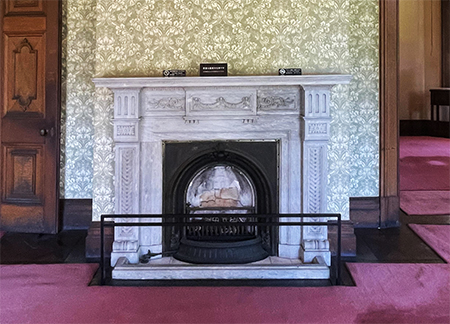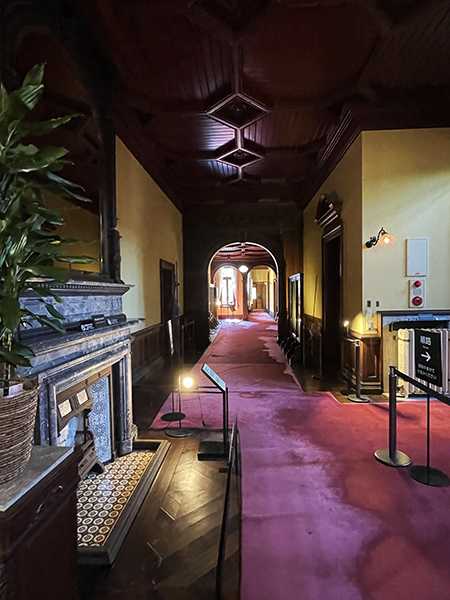


明治の初年に北海道の開拓が進むにつれて、欧米からの暖房機器の輸入、国産化がすぐに開始されていった。幕末〜明治初期の志士たちは「北門の鎖鑰(さやく〜外敵の侵入を防ぐ重要な場所の意)」というコトバを交わし合っていた。日本国家として帝国主義列強、もっとも具体的脅威としてロシアによる「南下占領」を警戒し、それへの最大の国防作戦として北海道島への殖民、日本領土化の実質を担保しなければならないということが熱病のように国民の多くの意識を駆け巡っていた。
明治維新という政変にとってこの「北門の鎖鑰」論は大きな動機要因を形成していたと思う。武力によって国家を支配してきた徳川政権の正統性が、外圧によって大きく揺らぐことになったのだ。「イヨッ“征夷”大将軍!」と、直接、徳川将軍の行列に対して罵倒した記録もある。
幕末期に諸藩は北辺防備のために北海道沿岸部各地に「陣屋」を築いて越冬滞陣していたが、日本の通風重視の建築では寒さに対して決定的に破綻して、多くの病死者を続出させた。ロシアと戦う前に北海道の過酷な寒さによって軍事も戦略破綻を来していたのだ。
そういった危機感から、のちに総理大臣にも就任する明治初期の箱館戦争での新政府側指揮官・黒田清隆は自ら寒冷風土に適応した建築を研究するに至る。そういう建築研究が極まって、自ら屋根に上って現場工事に突然参加するほど没入していたとされる。日本建築の寒冷への不適合を肌身で知って欧米の先進的建築を導入しようと、明治という時代は総力を傾けた。今日に残る札幌のマザー都市景観は、そういった建築技術の展示場機能を果たしていたとも思われる。
今日に至っても北海道が日本人にとって一種エキゾチズムを感じさせるのは、こういう明治期由来の寒冷地対応建築群の欧米風の景観印象が、その心理の基底にあるからなのでしょう。
この旧岩崎邸建築には、そういった同様のデザインコンセプトが投入されている。
なんといっても暖炉への異常なまでの数寄こころが発揮されている。英国人建築家としてもこれでもかと暖炉を多用する住宅建築というのは王侯貴族住宅並みであって、「一回、やってみたかった」建築だったかも知れない(笑)。

北海道住宅ではこうした暖炉は工事価格的に庶民にはまったく無理であり、一般的にはストーブ暖房の採用に向かっていった。ルンペンストーブというように浮浪者、乞食を表現する名詞を冠されて卑語されるような、低価格で実用性重視のものが導入された。
一方で「お雇い外国人」として本国にいて得られる報酬の数倍と言われるギャラで来日した英国人建築家が、東京上野の高台の家で社会の最上流人士のために、贅沢にも各室毎に設置した暖炉には、その石材に重厚なデザイン加工までもが施されている。その設計指導の下で明治の職人たちは必死に「生きた」近代住宅建築の技術習得に励んだに違いない。
この旧岩崎邸には、近代国家への懸命なキャッチアップを志向する明治日本のある種の凄みを感じさせられてならない。
その後、日本人建築家という存在を育てたルーツ文化がここにはあるのでしょう。
English version⬇
The introduction of the Meiji Era’s culture of hard work in fireplaces.
Introduction of the concept of indoor climate control. Brilliant masonry sculpture design. Under the guidance of an English architect, Meiji craftsmen worked hard to master their skills. …
As the development of Hokkaido progressed in the first years of the Meiji era, imports of heating equipment from Europe and the United States and domestic production soon began. The samurai of the late Edo period and early Meiji period exchanged the phrase “the key to the northern gate” (meaning an important place to prevent the invasion of foreign enemies). The Japanese nation was wary of the “southward occupation” by the imperialist powers, most concretely Russia, and as the greatest national defense strategy against this threat, it was as if a fever was running through the consciousness of many of its citizens that the colonization of Hokkaido Island and its territorialization as Japanese territory must be secured.
I believe that the “lock on the northern gate” theory was a major motivating factor for the political change known as the Meiji Restoration. The legitimacy of the Tokugawa regime, which had led the nation by force, was greatly shaken by external pressure. There is a record of a Tokugawa shogun directly cursing a procession of his subordinates, saying, “You are a barbarian general, aren’t you?
In the final days of the Tokugawa shogunate, clans built “camps” along the Hokkaido coastline to protect their northern fronts during the winter, but Japan’s ventilation-oriented architecture failed decisively against the cold, resulting in many deaths from disease. Before fighting the Russians, the harsh cold of Hokkaido had already caused a strategic failure in the military.
This sense of crisis led Kiyotaka Kuroda, the commander of the new government during the Hakodate War in the early Meiji period, who later became prime minister, to conduct his own research on architecture adapted to the cold climate. It is said that he was so absorbed in his architectural research that he even climbed onto the roof himself and suddenly participated in on-site construction work. Knowing firsthand that Japanese architecture was not suited to the cold, the Meiji period (1868-1912) saw a concerted effort to introduce advanced architecture from the West. The mother city landscape of Sapporo, which remains today, is thought to have served as an exhibition hall for such architectural technology.
The reason why Hokkaido still evokes a kind of exoticism for Japanese people today is probably due to the exotic landscape impression of the cold-weather-responsive architecture of the Meiji period that lies at the base of their psychology.
This former Iwasaki Residence building also incorporates such a similar design concept.
The fireplace is a symbol of the extraordinary “sukiyoko” spirit. Even for an Englishman, a residential building with so many fireplaces is comparable to a residence for royalty and aristocracy, and it may have been something he “wanted to try at least once” (laughs).
In Hokkaido housing, such fireplaces were not feasible for the average person due to the cost of construction, and the general trend was toward the use of stoves. Low-priced, utility-oriented stoves were introduced, such as the lumpenstove, a derogatory term with a noun to describe a hobo or beggar.
On the other hand, a British architect who came to Japan as a “hired foreigner,” paid several times what he would have been paid in his home country, lavishly installed fireplaces in each room of a house on a hill in Tokyo’s Ueno district for the highest-ranking members of society, and even had the stone materials heavily processed in a profound design. Under the guidance of these designers, Meiji craftsmen must have worked hard to master the techniques of “living” modern residential architecture.
The former Iwasaki Residence gives one the impression of a certain kind of awesome Meiji Japan, which was eager to catch up with the modern nation.
Here must be the root culture that subsequently nurtured the existence of Japanese architects.







コメントを投稿
「※誹謗中傷や、悪意のある書き込み、営利目的などのコメントを防ぐために、投稿された全てのコメントは一時的に保留されますのでご了承ください。」
You must be logged in to post a comment.